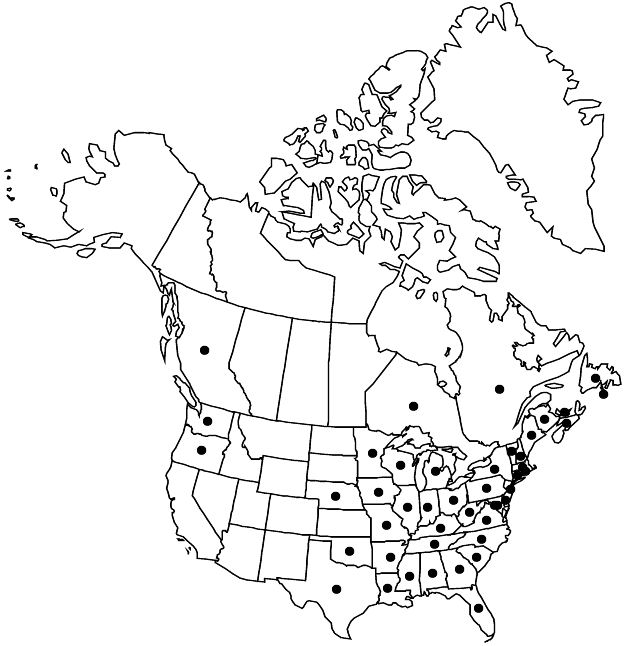Difference between revisions of "Viola lanceolata"
Sp. Pl. 2: 934. 1753.
FNA>Volume Importer |
FNA>Volume Importer |
||
| Line 16: | Line 16: | ||
|name=Viola lanceolata subsp. vittata | |name=Viola lanceolata subsp. vittata | ||
|authority=(Greene) N. Russell | |authority=(Greene) N. Russell | ||
| + | |rank=subspecies | ||
}} {{Treatment/ID/Synonym | }} {{Treatment/ID/Synonym | ||
|name=V. lanceolata var. vittata | |name=V. lanceolata var. vittata | ||
|authority=(Greene) Weatherby & Griscom | |authority=(Greene) Weatherby & Griscom | ||
| + | |rank=variety | ||
}} {{Treatment/ID/Synonym | }} {{Treatment/ID/Synonym | ||
|name=V. vittata | |name=V. vittata | ||
| − | |authority= | + | |authority= |
| + | |rank=species | ||
}} | }} | ||
|hierarchy=Violaceae;Viola;Viola lanceolata | |hierarchy=Violaceae;Viola;Viola lanceolata | ||
| Line 49: | Line 52: | ||
-->{{#Taxon: | -->{{#Taxon: | ||
name=Viola lanceolata | name=Viola lanceolata | ||
| − | |||
|authority=Linnaeus | |authority=Linnaeus | ||
|rank=species | |rank=species | ||
| Line 64: | Line 66: | ||
|publication year=1753 | |publication year=1753 | ||
|special status=Endemic | |special status=Endemic | ||
| − | |source xml=https://jpend@bitbucket.org/aafc-mbb/fna-data-curation.git/src/ | + | |source xml=https://jpend@bitbucket.org/aafc-mbb/fna-data-curation.git/src/f50eec43f223ca0e34566be0b046453a0960e173/coarse_grained_fna_xml/V6/V6_229.xml |
|genus=Viola | |genus=Viola | ||
|species=Viola lanceolata | |species=Viola lanceolata | ||
Revision as of 22:03, 16 December 2019
Plants perennial, acaulescent, stoloniferous, 5–30 cm; stolons pale, often rooting and leafy at nodes; rhizome slender, fleshy. Leaves basal, 2–6(–9), ascending to erect; stipules linear-lanceolate, margins entire or irregularly lacerate (at least distally), apex acute; petiole 2–12 cm, glabrous or pubescent; blade unlobed, lanceolate or narrowly elliptic to nearly linear, 2.5–12 × 0.7–2.5 cm, longer than wide, base attenuate, margins serrate, mostly eciliate, apex acute, mucronulate, surfaces glabrous. Peduncles 2–17 cm, usually pubescent. Flowers: sepals ovate to lanceolate, margins mostly eciliate, auricles 1–2 mm; petals white on both surfaces, lowest and sometimes lateral 2 purple-veined, lateral 2 sparsely bearded or beardless, lowest 7–12 mm, spur white, gibbous, 1–2 mm; style head beardless; cleistogamous flowers on prostrate to ascending peduncles. Capsules ellipsoid, 5–8 mm, glabrous. Seeds beige to bronze, 1.5–2.5 mm. 2n = 24.
Phenology: Flowering Mar–May.
Habitat: Open to semi-open wet areas, bogs, meadows, pond and lake shores, stream banks, seasonally inundated depressions
Elevation: 0–2000 m
Distribution

St. Pierre and Miquelon, B.C., N.B., Nfld. and Labr. (Nfld.), N.S., Ont., P.E.I., Que., Ala., Ark., Conn., Del., D.C., Fla., Ga., Ill., Ind., Iowa, Ky., La., Maine, Md., Mass., Mich., Minn., Miss., Mo., Nebr., N.H., N.J., N.Y., N.C., Ohio, Okla., Oreg., Pa., R.I., S.C., Tenn., Tex., Vt., Va., Wash., W.Va., Wis.
Discussion
Viola lanceolata occurs in small colonies; individual plants are interconnected by stolons.
Viola lanceolata subsp. vittata was recognized by N. H. Russell (1955) based on its linear leaf blade shape. The range in leaf blade shape appears to have no distinct line of demarcation. Some believe that leaf shape differences and near restriction to the coastal plain support recognition at some level. Studies are necessary to resolve this issue.
J. H. Shultze (1946) reported that Viola lanceolata was introduced into Washington in the early 1900s primarily from Cape Cod and Wisconsin as a result of importation of cranberry vines. In British Columbia, it is known from Lulu Island, where it was introduced from eastern North America (G. W. Douglas et al. 1998–2002, vol. 5).
Viola lanceolata reportedly hybridizes with V. primulifolia var. primulifolia (= V. ×modesta House) and V. macloskeyi (= V. ×sublanceolata House).
Selected References
None.